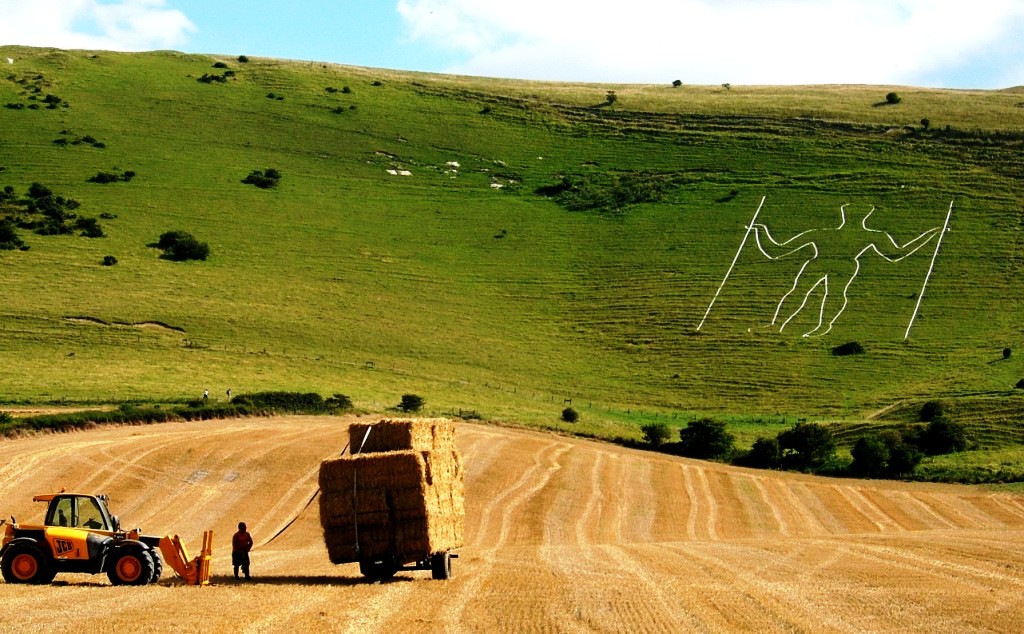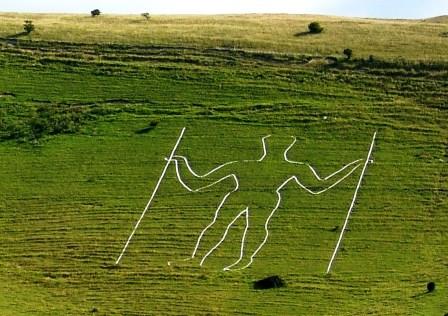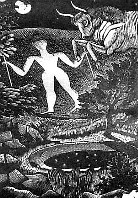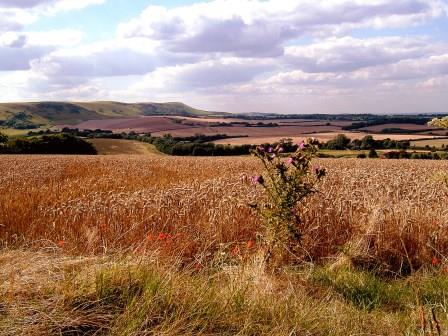|
A personal journey by Alex I Askaroff
Let me tell you what I
know of this old giant that lives a stone-throw from my home of Eastbourne.
Stare toward the rising sun and see me stride,
Bow before your mighty lord or carrion birds will sing,
The grey wolf will howl and deeds of woe
Will draw down upon the southern lands.
The dragon will rise from its watery rest and devour all.
Saxon Chronicles
Six miles north-west of
Eastbourne, Ordinance Survey TQ543034. Looked after by the
Archaeological Society since 1925 after it was gifted by the Duke of
Devonshire and painted regularly by the Long Man Morris men. Right,
that's enough of the tech stuff . I also remember the Scouts painting him
bright white most years.
The Long Man of
Wilmington by Alex Askaroff

I took this photo at
harvest time a few years ago. If you would like a better resolution copy
just mail me: alexsussex@aol.com
Firstly let's go up the small hill past the remains of the old Priory to what is
now a car park. This is where we get the best view of our white giant
clothed in green. After living near him and visiting
him all my life I will tell you everything I
have ever learnt about the mystical old man of the downs and it's a
great tale. Don’t be scared he
does not bite!
He always looks his best with the afternoon sun on him.
What is his name I hear you ask? He is now called The Long Man of
Wilmington. What his real name was has been lost through the folds
of time.
What we know of our
local giant is scatty to say the least. There are a hundred different
theories that have come up over the decades and much
has been messed around with. For instance his
outline now is breeze block painted in lime wash. About 150 years ago it
was lumps of brick but before that we just don't know. This constant
preservation of the original idea has caused archaeologists a real
headache.
How Old is the
Long Man of Wilmington
The first documentation of
him that I have come across comes from an illustration from 1710 and what a different character
he was, hair, eyes, armed with tools and a beard. It
was an artists impression and probably far from accurate.
So we must ask ourselves is he older than that? Because of the regular
maintenance of his outline over the years it is impossible to date him
using traditional carbon dating or other methods.
You almost have to use a Sherlock Holmes approach and take in the whole
area to work out a date. In the summer of early 1870's the Archaeological
Trust decided to enhance his outline with white painted bricks
and re-cut his outline. Did they change it? Yes. More
of why later.
The great King is dead. With his
saintly tongue
Our leader stood fast against those warring
families that sought to divide this land.
Without his staffs of divine power our path can only be war.
Lock away your chattels-hold your children-for a darkness falls.
Death of Edward the Confessor
Reading University have dated him to around 1545 but was that just an
educated guess? Probably. The area is littered with finds around the Giant
from Neolithic times,
Bronze Age, Iron Age, Roman or just about any period. There is no doubt
that this area has been inhabited from the earliest human times. Also because what we see
today is not
the original but inspired and built over the original, it is guess
work.
Something
of interest is that at the base of The Old Man there are several
hand-cut chalk blocks scattered around. they are roughly hewn out in
rectangular form and you can make out the chisel marks on a few. They
are rare now but in the summer of 2009 there were still a few there. Too
heavy for tourists to steal. These were probably from the original
Giant and an expert could identify what sort of tools were used to make
the block. This would be very useful in identifying the Giants real age.
Before
regular maintenance and renovations his form would go unseen for long periods of time.
Locals would be working in the fields and the light
and wind would be
just right, they would look up and see the giant appear then disappear
just as quickly. It must have given the magnificent old man of the
hills a magical touch.
We must wonder why people
would make such a giant.
The Facts
Lets look at the facts. The facts are simple. He is almost 230 feet (70
m) tall and carved out of the chalk hillside with a significant degree
of skill. This only becomes apparent from standing close at the base of
our giant. The proportions are so cleverly devised that, from a
distance, he is a very good outline of a human and you do not realise
how huge he is until you are right next to him. Amazingly
as Griff Rhys Jones found out when
you are at his feet he is almost invisible.

The Long Man of Wilmington is so perfectly
proportioned that he could be a few feet high but is in fact 230 feet
tall.
Standing at his feet
looking up you can see that he has been elongated on the sloping
hillside. He is the second largest representations of the human figure
in the world and the tallest in Europe. Not bad, eh?
I thing the largest is in Peru.
Is he an ancient god or
a giant that lived long ago? Is he holding staves, divining rods,
measuring staffs, or
battle staffs? Could he even be holding open the gates to another world?
Could he be striding across the swollen River Cuckmere, with his staves
for support, to rescue villagers from a great flood? The Cuckmere valley
has a tidal river, at its centre, that is prone to flooding.
Strangely both his feet used to point outwards but someone moved his
left foot!
Was he
carved to pacify old demons, an ancient deity or was he carved to
celebrate a grand victory or just as a local hero or simply to ensure a
healthy harvest? There are certainly many more questions of him than
answers available. But if you are ever there as the sun drops, and
Windover Hill becomes dark against the night sky, there is a magic in
the air, a power, that you can feel through your very bones.

My 1966 Daimler at the Long Man. Photo by Alex
Askaroff
The Long Man of Wilmington is set into an
unnaturally flat-topped North-facing hillside that has been flattened
and lays at 28 degrees. The Giant lays on a slightly concave mound in
concave hillside that has superb acoustics rather like an amphitheatre
in ancient Greece. Being concave he is visible
from much larger angles than if he were flat. It all looks well to
thought out to be a simple piece of work like the White Horse a little
further down the lane.
Was it an old
flint site of Neolithic man or a chalk pit used by the Romans
to make their
favourite building ingredient, concrete? There are flint pits above him
and even older Bronze age Long-Burrows on Windover Hill.
Also to the left of the Giant are chalk pits. So we can see all around
human have been busy.
The
Long-Burrows above the Long Man are from the Bronze Age. Some say that
the largest Long Burrow in Sussex must have something to do with our
giant even though that would mean he over 1,500 years older. Makes sense
when you think about it. If people were going to take the time to build
a great burial mound upon a high place to an ancient chieftain, why not
mark the special place with a giant protector of the dead!
Then we
have the Romans. Did they make an outline of one of their great emperors
to impress the locals? Did a marauding Viking army carve out one of
their warring gods to frighten the population for miles around. Did Odin
walk amongst us in days of old!
Could the hillside have been dug for chalk and flints
leaving a blank landscape just itching for an enthusiastic artist to
create a giant? Could a few of the monks from the abbey be filling in
some spare time by carving out a giant?
Interestingly the Giant does pick up the sun at different times of the
year leading a few to surmise that he was actually a solar almanac.
The truth
is that the list is endless. You could
get a wonderful selection of quite plausible answers by going to a
pre-school classroom and asking all the children where he came from.
When the
stone blocks were put in they dug up a lot of Roman pottery and that
gave some credence to the old legend that the giant was placed above the
grave of a Roman general killed in battle. They say
that his grave is covered with golden artefacts. hey where's my spade
and metal detector!
If this even had an thread of truth the whole place would have been dug
to nothing by the Victorians whole loved nothing more than a picnic and
a dig, long before the protection of such ancient monuments.
To mention or not to mention!
There is one, rather
rude, point worth mentioning. If you happen to see The Long Man early in the morning
after a sharp frost, a rather impressive appendage appears, showing that
his original form was far more revealing than his present one.
It disappears quite quickly. I have only seen it three times in 40
years. Over the
years he has often been defaced or rather repainted by visitors in
the night that have added his grand assets back. Are they
subconsciously putting him back to how he really did look?
If he was originally a
well-endowed fellow then he certainly would not have been carved in the
prim and proper Victorian era when showing an ankle was deemed
inappropriate, let alone his six-foot (2m) attribute! Also, to back this
theory up, when the Australian and New Zealand troops were stationed at
nearby Peacehaven. Peacehaven was formerly known as New ANZACS -because
of the Australian and New Zealand troops. Many of the soldiers who
helped clear local scrub and downland went back and told their families
of the giant that, when properly cleared, included his full manhood. And
why would old descriptions of him say He stands naked before the
shires? Even Kipling used this phrase. Now that
his ding-a-ling has been removed we can state that the Long Man
has had an early sex change?
During
WWII our giant was camouflaged to avoid the enemy using him as a
landmark but was soon sparkling again with a coat of white road paint.
Before he was covered up a reconnaissance aircraft took a picture of him
showing his large appendage in its full glory! So it is on record.
In 1874 the Reverend William De St Croix marked out the
Giants rough outline in yellow painted bricks but they were replaced in
1891 with white ones. You can get a picture of the amount of work going
on here. Every few years thankfully there is someone renovating the old chap.
In 1969,
just before earlier bricks were replaced with concrete and breeze blocks,
archaeological
digs by Reading University pronounced that the old man of the hill could
be no more than early 1600's.
Can that be true?
Long Man rituals
For every one of these
opinions there is an
opposite opinion, so the quest goes on.
The Long Man also attracts the weird and wonderful, from pagan rituals
to the more painful sight of Morris Men in all their glory.
White witches—the
friendly sort that have strong roots with mother earth,
Gia—have
held ceremonies at the foot of the our Old Man
of the downs, as have the Druids.
Presently celebrations are held on the closest Sunday
to the eight Wiccan Sabbats throughout the year. The biggest are
Beltaine or May Day and Lughnasadh or Lammas Day when people give thanks
to nature for her bounty and life.
On May Day the Long Man Morris Men
mark their dancing season start by a special dance performed at dawn at
the foot of the Old Man of the downs.

May by Eric Ravilious 1925, note
the dew pond unique to the area.
There are plenty that believe he has healing powers and many have
claimed our Long Man as their own. Making love on the
Giant is supposed to bring you a child of your choice!
In my mind I have no doubt that he is
of ancient origin but proving if he is 500 or 5,000 years old is a
impossible task. I have seen him, all of my
life, lying quietly in the soft green of the downland and serenely
gazing over the farmlands below. He watches us, as we rush through our
hectic lives, as no more than ants below his feet.
If
you ever get the chance go and stand where the Old Man of the downs is
and see what he sees. You will be looking at one of the most beautiful
sights in Sussex. Be careful though as it is a steep climb. I remember
getting to his head and turning around and a wave of vertigo flooded
over me.
All around this area it
is rich in pagan history. In Berwick churchyard, hardly a stone’s
throw away, stands a pre-Christian worship stone. Neolithic man was
known to have flint mines near this spot and their burial grounds along
with Bronze Age Long-Burrows are
dotted over the high places of the Downs. Ancient man cleared the slopes of
forests thousands of years ago for fuel, shelter and tools.
Let us sum up. So far we
have Stone Age, Bronze Age, Roman, Viking, Middle Age, Georgian,
Victorian and more, all responsible for our grass art!
Celtic Tales
My
favourite fable comes from an early Celtic tale. Two giants, brothers, lived on
the highest places of ancient Sussex, and elsewhere going by other
tales. One at Firle Point, later to
become Firle Beacon one at Windover Hill.
They were
jealous and violent always arguing about who had the most land and who
was the most powerful. They would grumpily survey their lands from these
Sussex high-points. One day a furious row broke out over a grazing cow
that had wandered from one giants land to the other. The hills thundered
as they fought an epic battle to finally prove who was the most
powerful.
The Firle
Giant seized his brother after beating him senseless with his hammer and
hurled him high into the sky over the downs. He fell onto the side of
the hill dead as a doornail. The local villagers, sad at the lose of
their protector and scared that they would not have
his protection anymore came up with a cunning
plan. They painted
his outline in the hill to scare away strangers.
The Firle
Giant having no one to argue with simply sat on his hill-top and
miserably faded away. Today he is no more than a large mound of
grass atop Firle Beacon.
Great
story. Oh how I love the old stories that flow
through this land like well-aged wine.
Finally
In my opinion the most
likely origin of our giant is Celtic. They had a harvest god
called Lugus. He was very similar to our Giant, right down to the
staffs and spot on the time when the Celts were in this area.
It is also interesting to note that one of their most religious Celtic
trees, the yew, is in the churchyard. It is said to be one of the oldest
yews in the world. Some say dating back to the fourth century AD.
The yew
held great importance in the Celtic year because they
believed it held the secrets to immortality and they often buried their
dead around them. It has always been thought
that the church at Wilmington was placed on a pre-Christian worship site.
I do believe that ancient man
gazed upon our giant, as we do today. there is just something mystical about the
area where he lays. There is just too much going on there what with
ancient burial sites, lay-lines, fertility hot spots, early settlements, Pre-Christian monuments, monks,
churches, witches, all set into one of the most
beautiful areas on planet Earth.

The view from Wilmington by Alex Askaroff
Although
our Giant's origins has been lost to us over the centuries and his secret history
hidden for now, there is no doubt that today our
Wilmington Giant stands proud as the
protector of these superb and ancient lands.
All said and done isn't it better not really knowing.
The Old Man of the Downs holds his secrets close, it's part of his charm.
Well,
we are going to leave him to rest now and head forward on our journey.
Come with me for we have many miles to travel and no time to waste.
For the next part of our journey click here:
Al's Alfriston Guide.
That's it, I do hope you enjoyed my work.
I spend countless hours researching and writing these pages and I love to hear from
people so drop me a line and let me know what you thought: alexsussex@aol.com

Most of us know the name Singer but few are aware of
his amazing life story, his rags to riches journey from a little runaway
to one of the richest men of his age. The story of Isaac Merritt Singer
will blow your mind, his wives and lovers his castles and palaces all
built on the back of one of the greatest inventions of the 19th century.
For the first time the most complete story of a forgotten giant is
brought to you by Alex Askaroff.
Fancy a funny read:
Ena
Wilf & The One-Armed Machinist
A brilliant slice of 1940's life:
Spies
& Spitfires

Alex's stories are now available to keep.
Click on the picture for more information.
Skylark
Country
|




